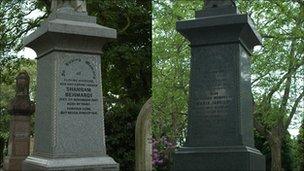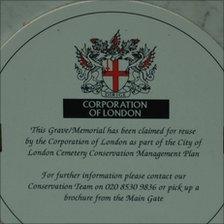Reuse of graves 'needed to prevent crisis'
- Published

The new inscription (L) and the old (R) on a reused memorial at the City of London cemetery
In one of the UK's biggest, most historic cemeteries on the edge of Epping Forest, headstones and memorials stretch across 200 acres. And it is full. With no prospect that people will stop dying, managers have had to take bold measures.
At the City of London Cemetery and Crematorium, they reuse old graves. Campaigners say this could be the solution to a nationwide shortage of burial space.
Hundreds of families were contacted about private graves which had not been used for more than 75 years, and which were known to have depth for at least two more burials.
More than 30 of the plots have since been chosen by people for their final resting place.
On one historic grave, the memorial even has one set of names on its reverse side - dating from 1902 and 1908 - and a fresh name on the front.
In another corner of the site, remains have been dug up from more than 1,000 public graves so new plots can be created; 360 have already been used.
Superintendent and registrar Gary Burks thinks the government wrongly assumes the public will be appalled by the idea.

Grade I listed Brompton cemetery has space for only 5-10 more years
He said: "Our name is sometimes mentioned in stories about reuse, including once by an American article which bounced around the world. I thought, 'Oh I'll get calls about this'. But there was nothing."
"On one occasion, an Irish lady did get in touch to say 'are you going to reuse my grave, then?' After it was explained she said "Well, that's fine, I don't mind what you do once I'm dead.'"
Critical problem
A recent audit of burial space, external by the Greater London Authority found eight boroughs were completely full, with no space for new burials. Another 10 boroughs have a "critical" problem, and are predicted to exhaust available space in 10 years.
The greatest focus is on London, but the problem is nationwide. Cemeteries have been expanded in Leeds; there are problems in Surrey and Lincolnshire; in Rhyl it is estimated the cemetery could be full within 18 months.
Dr Julie Rugg, from the Cemetery Research Group at the University of York, says the only solution to the crisis is to return to the "old tradition" of reusing graves.
"The Victorian idea was that land would be reused once a person's remains had disappeared, after about 100 years."
Rules were introduced in London in 2007 to allow "lift and deepen", where old remains are removed from a grave, then replaced once it has been dug deeper to allow for more burials.
But despite the crisis being most acute in the city, no London boroughs have used those powers.
'Cramming'
One interim solution to avoid reuse has been what are known as "created" grave spaces.
The GLA audit reports that Brockley & Ladywell Cemetery in Lewisham "found" virgin space by demolishing chapels and greenhouses, and clearing land that was ornamentally planted.
Dr Rugg calls these "desperate measures". The industry calls them "cramming".
Tim Morris, of the Institute of Cemetery and Crematorium Management, is worried about the impact of the stop-gap measures.
"Authorities who have run out of space are removing paths and planted areas to use them for burial," he says. "Cemeteries are being damaged by these tricks."
English Heritage has listed many burial grounds and says it has no objection to the reuse of graves in principle, as long as heritage is protected.
"I could have simply removed trees," said Mr Burks of his attempts to find space, "or brought graves down to the edge of the road, but that would damage the overall landscape".
So if it can be done, and public opposition is a myth, why isn't reuse happening widely?
"Everyone is waiting for someone else to do it," Mr Burks says. "Nobody wants to be the one in front of the camera when it happens. We are all risk averse."

More than 30 reused graves have been sold at the City of London Cemetery
'Sensitive subject'
In 2007 the Labour government said it would be "right" to reuse graves nationwide after 100 years. But two years later, the project was shelved.
The Scottish government consulted on "lift and deepen" in 2010 and found both Church and public broadly in favour, but the practice has not been introduced.
The Ministry of Justice says: "We have offered help and advice to authorities that have contacted us and have issued guidance for burial ground managers."
"We are looking into what other options could be available in future. Clearly, this is a sensitive subject and we will give careful consideration before any decisions are made."
Dr Rugg says central government should intervene to stop cemeteries deteriorating further because of cramming.
"Nobody opposes reuse," she says. "But it takes a great deal of ministerial will to get a change through, and we haven't had that since the burial acts of the 1850s."
Tim Morris thinks pressure is mounting for a new law, covering England and Wales.
He says: "It's really frustrating. Reuse is common in lots of other countries, and was common practice in the UK until the 1850s. Reuse is the simple answer to everything".
- Published14 July 2010